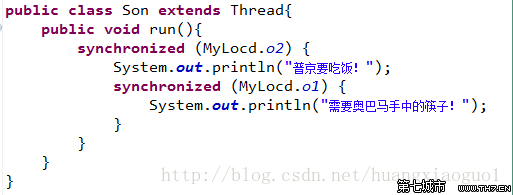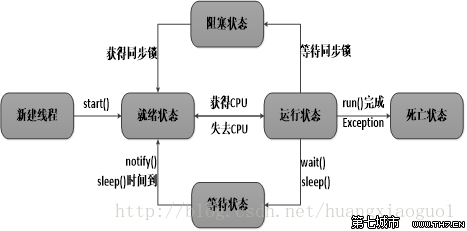Home >Java >javaTutorial >Regain the basics of Java (18): Summary under multi-threading
Regain the basics of Java (18): Summary under multi-threading
- 黄舟Original
- 2017-01-16 10:34:391779browse
Regain the basics of java (18): Summary under multi-threading
1. Deadlock
1. Synchronization lock can be solved Thread safety issues, but synchronization locks will cause deadlock problems; 2. Deadlock means each other occupies each other's resources, causing the program to pause and unable to continue running. 3. The probability of deadlock is very small, but the harm is very high. 4. Case: Obama and Putin had a meal together. The food was all served. It was very delicious. They were very hungry. Let’s eat...but each person only has one chopstick in his hand...if no one is willing to share his chopsticks. , then they can only starve...watch...greedy...saliva...a. Obama is a thread. Obama wants to eat and wants Putin's chopsticks. b. Putin is a thread. Putin wants to eat. , want Obama’s chopsticks c. Nested lock + cross lock



##Note: Threads occupying the resources required by each other is deadlock
2. Communication between threads
1、在实现线程安全时,程序进入同步代码块后就会自动上锁,直到程序把代码块中的代码执行完后才会进行下步操作。
2、每个对象都有一把锁,那么开锁的方法就被定义到了Object类中;
Public final void wait(),让当前线程等待,同时释放锁,直到被再次唤醒。
public final void wait(long timeout),在指定时间内让当前线程等待,同时释放锁,
wait()和sleep()都可以让当前线程等待,区别:
1,sleep():释放执行权(等待),不释放锁
2,wait():释放执行权(等待),同时释放锁如果调用的是无参的wait()方法,那锁就一直释放,当前线程一直等待,还需要唤醒。
Object类提供了notify()方法用来唤醒某个被wait()的锁,也就是唤醒线程细节:
wait()和notify()方法都是操作锁的,而锁存在于同步中,也就是说这两个方法必须出现在同步中(同步代码块或同步方法)。
同步锁不仅可以解决昨天的线程安全问题,还可以实现线程间的通信3、线程间的通信
例子:一个线程输出10次1,一个线程输出10次2,观察执行结果
现要求交替输出“1 2 1 2 1 2...” 或 “2 1 2 1 2 1...
public class Testnotif1 extends Thread{
public void run(){
for (int i = 0; i < 10; i++) {
synchronized (MyLocd.o1) {
System.out.println(1);
MyLocd.o1.notify();
try {
MyLocd.o1.wait();
} catch (InterruptedException e) {
// TODO Auto-generated catch block
e.printStackTrace();
}
}
}
}
}
package cn.itcast.Thread;
public class Testnotif2 extends Thread {
public void run() {
for (int i = 0; i < 10; i++) {
synchronized (MyLocd.o1) {
System.out.println(2);
MyLocd.o1.notify();
try {
MyLocd.o1.wait();
}
catch (InterruptedException e) {
e.printStackTrace();
}
}
}
}}
package cn.itcast.Thread;
public class Testnotif {
public static void main(String[] args) {
// TODO Auto-generated method stub
Testnotif1 f1=new Testnotif1();
Testnotif2 f2=new Testnotif2();
f1.start();
f2.start();
}}线程之间是互相独立,这个通信指的是线程之间互相打个招呼,控制CPU 的随机性notify()方法 叫醒正在休息的线程
Object类该方法只能叫醒跟他共用一把锁(这把锁类似于中间人)的那个线程
- Generate consumer mode
- Inter-thread communication Classic case
public class MyLocd {
public static Object o1=new Object();
public static Object o2=new Object();}package cn.itcast.Thread;
public class TestHaizi extends Thread{
public void run(){
while(true){
synchronized (Kuang.al) {
if (Kuang.al.size() <= 0) {
try {
Kuang.al.wait();
} catch (InterruptedException e) {
// TODO Auto-generated catch block
e.printStackTrace();
}
}
Kuang.al.remove(0);
Kuang.al.notify();
System.out.println("孩子吃了一个,框里还有" + Kuang.al.size() + "个水果!");
try {
Thread.sleep(1000);
} catch (InterruptedException e) {
// TODO Auto-generated catch block
e.printStackTrace();
}
}
}
}}package cn.itcast.Thread;
public class Testnongfu extends Thread{
public void run(){
while(true){
synchronized (Kuang.al) {
if (Kuang.al.size() >= 30) {
try {
Kuang.al.wait();
} catch (InterruptedException e) {
// TODO Auto-generated catch block
e.printStackTrace();
}
}
Kuang.al.add(1);
Kuang.al.notify();
System.out.println("农夫在框里放了一个,框里总共" + Kuang.al.size() + "个水果!");
try {
Thread.sleep(500);
} catch (InterruptedException e) {
// TODO Auto-generated catch block
e.printStackTrace();
}
}
}
}}package cn.itcast.Thread;
public class TestNongfuHaozi {
public static void main(String[] args) {
// TODO Auto-generated method stub
Testnongfu t1=new Testnongfu();
TestHaizi t2=new TestHaizi();
t1.start();
t2.start();
}}
3. Thread status

4. Singleton Design Pattern
*********************只能创建出来一个对象***************************
//懒汉式
class Single{
private static Single s = null;
private Single(){}
public synchronized static Single getInstance(){
if (s == null){
s = new Single();
}
return s;
}}
//面试时懒汉式出现的几率非常大//饿汉式
public class Singleton{
private static Singleton s = new Singleton ();
private Singleton (){}
public static Singleton getInstance(){
return s;
}
} 懒汉式存在线程安全问题,虽然能解决,但是会造成效率变低,因此开发的时候建议使用饿汉式实现单例设计模式

